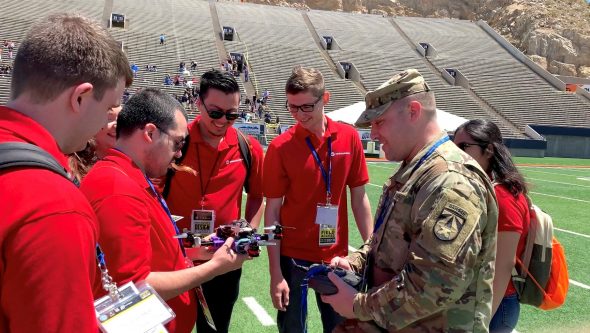Engineering students win third place at Army drone design competition

Engineering students win third place at Army drone design competition
By David Staudacher
A team of UIC engineering students — led by a faculty member from mechanical and industrial engineering — won third place and a $3,000 cash prize during the U.S. Army Combat Capabilities Development Command (CCDC) Inaugural HBCU/MI Design Competition at the Sun Bowl Stadium at the University of Texas at El Paso held in April.
The UIC team was made up of mechanical and industrial engineering students Rachel Ann Cruz of Woodridge, Eloise De Castelnau of Chicago, Alexander Rodriguez of Des Plaines, Omar Ron of Waukegan, David Laczak of Chicago, electrical and computer engineering student Kathleen Galicia of Chicago, computer science student Thomas Hein of Geneva, and Jonathan Komperda, a lecturer in mechanical and industrial engineering.
More than 1,700 institutions were eligible for the competition, but only the top 11 proposals were awarded grants and selected to travel to the finals. The contest challenged undergraduate students to propose solutions to real-world technological problems faced by U.S. Army researchers in the focus area of unmanned aerial vehicles.
The competition consisted of a poster presentation, hands-on inspection and judging of the drone, and a flight demonstration.
“We performed extremely well in the poster presentation; our students were extremely prepared and ready to present,” Komperda said. “Our flight demonstration went off nearly without a hitch. There was a hesitant moment where the drone briefly grazed the ground, but the pilot [Omar Ron] was able to recover quickly and complete the course.”
The flight course consisted of pylons placed across a football field. The drone had to pass between pairs of pylons and return to the start position and land on a target.
For the flight test, the team was challenged to hover for 30 seconds directly over the landing target until signaled to move, navigate the pylon course, speed down the straightaway back to the landing zone, and touch down on the bullseye. Then the team had to power down the drone and replace the battery and repeat the flight path.
“This entire demonstration had to be completed in less than 10 minutes,” Komperda said. “UIC was able to complete the flight in 5 minutes and 47 seconds.”
“It was a very fun project to be a part of,” said mechanical and industrial engineering student David Laczak. “The whole idea of creating this drone with removable arms and having it be easily assembled and easily maintained was an interesting problem. The goal here was to remove any and all screws if possible and eliminate as many wires as possible and it was being held together with snap fits. It was a unique project.”
COMPETING BEFORE THE COMPETITION
For all the teams involved, getting to the competition was part of the challenge. The UIC team was one of only 11 teams awarded an $8,000 U.S. Army Research Laboratory (ARL) grant to develop a drone and participate in the ARL competition. Komperda was the principal investigator and Kenneth Brezinsky, professor of mechanical and industrial engineering, was the co-PI for the project titled, “Student Competition: Rapid Additive Manufacturing of Electrically Integrated Drone Arms.” Mechanical and industrial engineering assistant professor Patrick Lynch contributed to the proposal, setting up the team and advising the students.
The proposal addressed the elimination of wire bundles present in the arms of small UAVs using additive manufacturing technologies that are adaptable to field production techniques.
One design utilizes a dual extrusion head 3D printer to print highly conductive graphene-based layers to replace the wire bundles, while ABS or PLA plastic provides structural support. The resulting arm is a single piece, and integrated connectors are embedded to allow power transmission from the central hub to the arm and arm to the motor.
A second design consists of a milled circuit board, which replaces the wire bundles, and 3D printed structural material on the substrate of the circuit board. The 3D printed support material completes the quadcopter arm and electrically insulates the circuit board traces.
“Both designs eliminate copper wires, minimize assembly time, minimize user intervention, and focus on structural rigidity of the arm while reducing overall weight,” Komperda said.
The final design integrated milled circuit boards in the design of the drone arm, which snapped into the electronic speed controllers in a “USB-like” fashion. The entire drone body consisted of only 11 3D printed parts and could be assembled or disassembled without the use of tools. The design utilized a “snap-together” design for ease of assembly and maintenance and could be 3D printed in seven hours when printing all components simultaneously. The design focused on field production and was designed to be very user friendly so that assembly was natural without the use of complex manuals or require reference instructions. It was sized to be portable, easy to carry, light, and use as little material as possible in manufacturing.
“It was interesting to have a competition that was research based and a still a competition,” said mechanical and industrial engineering student Eloise De Castelnau. “At the encouragement of the judges, we filed a patent for the work we did for the snap-fit connection. It was novel work and the development of new technology.”
Contact
UIC News contributor
uictoday@uic.edu


